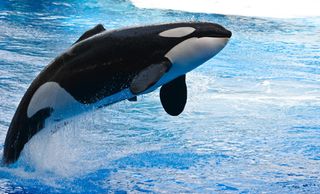New Killer Whale Species Proposed

Killer whales may not be just one species but rather four or more, with each hunting different prey, living in their own kinds of groups, prowling their own unique ranges and speaking in distinct ways, according to new genetic research.
With powerful bodies, sharp minds, and the ability to work together like packs of wolves, killer whales, also called orcas, can hunt down and kill virtually anything — including great white sharks and the largest creature to ever live, the blue whale. Orcas are actually not whales at all, but the largest of all dolphins.
Scientists had suspected more than one species of killer whale had existed for quite some time, based on marked differences in behavior and subtle physical variations. In the North Pacific alone, three distinct types of killer whales were recognized:
- Resident orcas eat mostly fish and sometimes squid. They live in large complex groups dubbed pods. Their dorsal fins are rounded at the tip and curved and tapering. Residents are extraordinarily vocal, with patterns complex enough for different dialects between pods.
- Transient orcas almost exclusively eat marine mammals, such as seals, sea lions, dolphins and whales, employing highly coordinated tactics to hunt their prey. They generally travel in smaller groups of fewer than 10 killer whales whose bonds are not as permanent as those seen with residents. Their dorsal fins tend to be straighter at the tip. Transients roam widely along the Pacific coast. Transient vocal patterns are less complex and less variable than those of residents.
- Offshore orcas are thought to feed primarily on schooling fish, although they might also eat sharks. They live in groups of dozens of animals. They appear physically smaller than residents or transients, and their fins appear more rounded at the tip with multiple nicks on the trailing edge. They travel far from shore. Little is known about their vocal patterns, but they seem to be completely different from those of residents or transients.
Three different types also seemed to live in the oceans surrounding Antarctica:
- The type-A looks like a typical killer whale, and lives in the open water, feeding mostly on minke whales.
- The type-B "pack ice killer whale" is smaller than type-A and dines on seals it knocks off the ice. They have very big oval-shaped eye patches.
- The type-C "Ross Sea killer whale," a dwarf species and the smallest of the three known Antarctic types, eats fish found primarily under the ice pack. They have very small eye spots that are more like broad lines instead of ovals.
Until now, however, scientists had not proved different species of killer whales existed. Genetic analyses had been inconclusive because scientists hadn't mapped the entire genome of the whales' mitochondria, a compartment within the cell inherited from the mother and which holds its own DNA.
Now, by using a relatively new method called highly parallel sequencing to decipher the entire genome of mitochondria from a worldwide sample of 139 killer whales from the North Pacific, the North Atlantic and the oceans surrounding Antarctica, "we were able to see clear differences among the species," explained researcher Phillip Morin, a geneticist at NOAA's Southwest Fisheries Science Center in La Jolla, Calif.
The analysis suggested that in Antarctica, types-B and -C are each species of killer whales distinct from type-A and each other. The level of dissimilarity between types-B and -C with other killer whales suggests their lineages diverged from other orcas roughly 150,000 years ago.
Sign up for the Live Science daily newsletter now
Get the world’s most fascinating discoveries delivered straight to your inbox.
"They have gray and white patterns you don't see in any other killer whales in the world," Morin noted.
The transients of the North Pacific also seem to be a separate species. The level of genetic differences found between transients and all other types of killer whales suggest their ancestors diverged roughly 700,000 years ago.
It remains unclear whether the resident, offshore, type-A Antarctic and North Atlantic types are a single species, separate species or separate subspecies — that is, a distinct breed within a species that in principle can interbreed with other members of its species.
"We need more samples to tell," Morin explained. "And collecting information on killer whales in the wild is really difficult."
Knowing how many species of killer whales there are can shed light on the role this predator has in the oceans. It is also critically important when it comes to conserving them.
"If you think of them as one global species, they're not threatened, but if you look at them as many different species, the multiple, smaller populations of killer whales that result could be seen as endangered," Morin said.
The scientists detailed their findings April 22 in the journal Genome Research.
- 10 Scariest Sea Creatures
- Scientist Has 'Snowball Fight' With a Killer Whale
- The World's Biggest Beasts
